Theorem with Solved Example Problems - Cramer’s Rule | 12th Business Maths and Statistics : Chapter 1 : Applications of Matrices and Determinants
Chapter: 12th Business Maths and Statistics : Chapter 1 : Applications of Matrices and Determinants
Cramer’s Rule
Cramer’s Rule
Gabriel Cramer, a Swiss mathematician born in the city Geneva in
31 July 1704. He edited the works of the two elder Bernoulli’s, and wrote on
the physical cause of the spheriodal shape of the planets and the motion of
their apsides (1730), and on Newton’s treatment of cubic curves (1746).
In 1750 he published Cramer’s Rule, giving a general formula for
the solution of certain linear system of n equations in n unknowns having a
unique solution in terms of determinants. Advantages of Cramer’s rule is that
we can find the value of x, y or z without knowing any of
the other values of x, y or z. Cramer’s rule is applicable
only when D ‚âÝ 0 ( is the determinant
value of the coefficient matrix) for unique solution.
Theorem (without proof) Cramer’s Rule:
Consider, 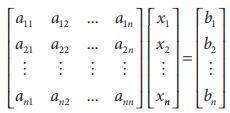
If AX = B is a system of n linear equations in ‘n’ unknowns such
that det (A) ‚âÝ 0, then the system has a unique solution.
This solution is,

where Aj is the matrix obtained by replacing the
entries in the jth column of A by the entries in the
matrix
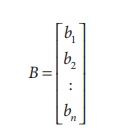
1. Non Homogeneous linear equations upto three variables.
(a) Consider the system of two linear equations with two unknowns.

The solution of unknown by Cramer’s rule is

(b) Consider the system of three linear equations with three
unknowns a1
x + b1 y + c1 z = d1
a2 x + b2 y + c 2 z = d2
a3 x + b3 y + c 3 z = d3

Example 1.19
Solve the equations 2x + 3y = 7, 3x + 5y
= 9 by Cramer’s rule.
Solution:
The equations are
2x +
3y = 7
3x +
5y = 9
Here 
∴ we can apply Cramer’s
Rule
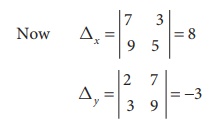
∴ By Cramer’s rule
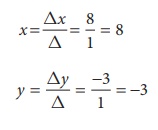
∴ Solution is x = 8, y = −3
Example 1.20
The following table represents the number of shares of two
companies A and B during the month of January and February and it
also gives the amount in rupees invested by Ravi during these two months for
the purchase of shares of two companies. Find the the price per share of A
and B purchased during both the months

Solution:
Let the price of one share of A be x
Let the price of one share of B be y
∴ By given data, we get
the following equations
10x +
5y = 125
9x +
12 y = 150
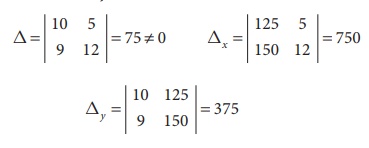
∴ By Cramer’s rule
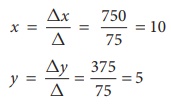
The price of the share A is ‚Çπ10 and the price of the share B is ‚Çπ5.
Example 1.21
The total cost of 11 pencils and 3 erasers is ‚Çπ 64 and the total
cost of 8 pencils and 3 erasers is ‚Çπ49. Find the cost of each pencil and each
eraser by Cramer’s rule.
Solution:
Let ‘x’ be the cost of a pencil
Let ‘y’ be the cost of an eraser
∴ By given data, we get
the following equations
11x + 3y =64
8x+3y=49
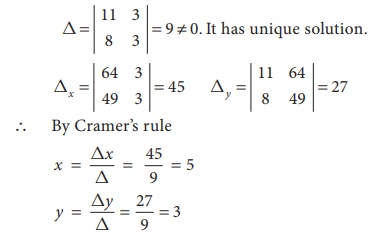
∴ The cost of a pencil is ₹ 5 and the cost of an eraser is ₹ 3.
Example 1.22
Solve by Cramer’s rule x + y +
z = 4, 2x ‚àí y + 3z = 1, 3x + 2 y ‚àí z = 1
Solution:

∴ We can apply Cramer’s
Rule and the system is consistent and it has unique solution.

The solution is ( x , y,
z) = ( ‚àí1,3, 2)
Example 1.23
The price of 3 Business Mathematics books, 2 Accountancy books and
one Commerce book is ‚Çπ840. The price of 2 Business Mathematics books, one
Accountancy book and one Commerce book is ‚Çπ570. The price of one Business
Mathematics book, one Accountancy book and 2 Commerce books is ‚Çπ630. Find the
cost of each book by using Cramer’s rule.
Solution:
Let ‘x’ be the cost of a Business Mathematics book
Let ‘y’ be the cost of a Accountancy book.
Let ‘z’ be the cost of a Commerce book.
∴ 3x + 2 y + z = 840
2x +
y + z = 570
x + y + 2z = 630
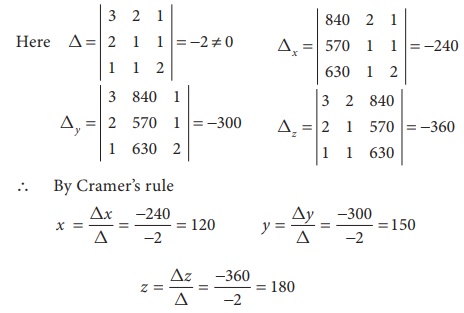
∴ The cost of a Business
Mathematics book is ‚Çπ120,
the cost of a Accountancy
book is ‚Çπ150 and
the cost of a Commerce book is ‚Çπ180.
Example 1.24
An automobile company uses three types of Steel S1,
S 2 and S3 for providing three different
types of Cars C1, C2 and C3.
Steel requirement R (in tonnes) for each type of car and total available
steel of all the three types are summarized in the following table.

Determine the number of Cars of each type which can be produced by
Cramer’s rule.
Solution:
Let ‘x’ be the number of cars of type C1
Let ‘y’ be the number of cars of type C2
Let ‘z’ be the number of cars of type C3
3x +
2 y + 4z = 28
x + y + 2z = 13
2x +
2 y + z = 14
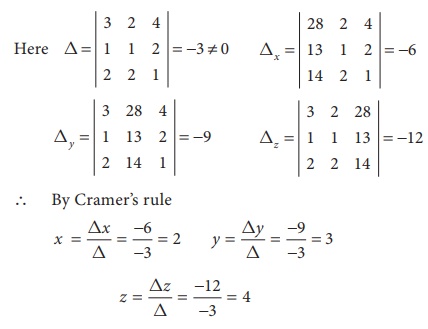
∴ The number of cars of
each type which can be produced are 2, 3 and 4.
Related Topics